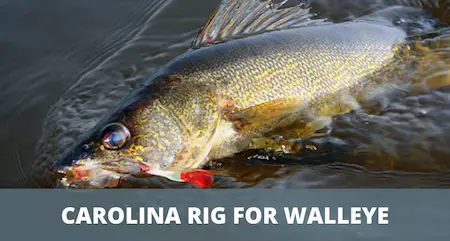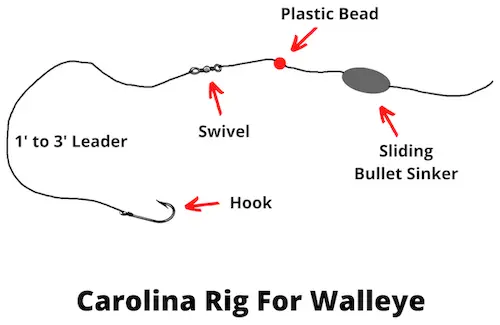UPDATED 03 NOVEMBER 2024
by Robert Ceran
The Carolina rig is a classical rig that’s been around for more than a century, and is used regularly by bass anglers.
But what many beginners don’t know is that you can use it equally well for catching walleye, and since it’s one of the easier rigs to set up, it’s a great choice if you’re new to walleye fishing.
In this article we’ll show you how to set up the Carolina rig for walleye, as well as the best tactics to catch lots of walleye with it.

Table of Contents
What is a Carolina rig?
The Carolina rig is one of the simplest rigs for walleye fishing. Basically, it consists of a sliding sinker riding on the main line, and a swivel tied between the main line and leader.

At the other end of the leader is either a hook (for live bait), or a jig head baited with a grub trailer.
Carolina rig for walleye vs bass – what are the differences?
If you’re a bass angler, chances are that you’re already familiar with the Carolina rig, which is one of the most popular rigs for bass fishing in the summer.
But it’s important to note that there are several key differences in how this rig is used for bass versus walleye.
The Carolina rig for bass is most often used with a casting rod and reel setup, and the sliding sinker is 1/2 oz or heavier (up to 1 oz or even more).
In contrast, a Carolina rig for walleye is fished with a lightweight spinning rod and reel setup, and the sinker is usually 1/4 oz or less (most often 1/8 oz).
So it’s fair to say that a Carolina rig setup for walleye is a finesse version of the same rig used for bass.
How to tie a Carolina rig for walleye
Tying a Carolina rig for walleye is very simple. You’ll need the following components:
- 7’ to 8’ medium light spinning rod
- 2000 size spinning reel
- 10 – 12 lb test braided main line
- 8 lb test fluorocarbon leader
- 1/8 to 1/4 oz sliding sinker
- Plastic bead
- Size 5 barrel swivel
- Size 6 hook (or medium sized jig head baited with grub tail)
Start by spooling your spinning reel with the braided main line, and then set it up on the rod with the line threaded through the line guides.
Then thread the sliding sinker on to the main line, followed by the plastic bead. After this, tie the main line to the barrel swivel. In case you’re wondering why you need the plastic bead – it stops the sinker from getting stuck on the knot.
Next, tie the fluorocarbon leader to the other eye of the swivel, and then tie either a hook or a jig head to the other end of the leader. The length of the leader should be at least 18 inches, but can be longer (up to 3 feet).
How to use a Carolina rig for walleye fishing
Since walleye are bottom dwelling fish, using a Carolina rig is a great way to present your bait to them just above the bottom.
If you’re using live bait, the simplest method is to cast out the Carolina rig to an area where walleye are likely to pass by on their foraging patrols. Great places for this are the drop off areas of structure, like underwater islands, mud flats, or points.
After you cast out your Carolina rig, you can place the rod in a rod holder and wait for a bite, which is good if you’re fishing with multiple rods. Alternatively, you can slowly retrieve the rig.
If you’re using a jig head baited with a grub tail, you need to retrieve it actively after every cast, to entice walleye to bite the lure.
The advantage of this approach is that you can cover more ground that way. Of course, you can also use both approaches in parallel, by using multiple rods.
When retrieving a jig on a Carolina rig, let the sinker sink to the bottom regularly, as this will stir up sediment, and call in curious walleye to investigate.
Most walleye anglers like to use a floating jig head combined with a Carolina rig, since that way the jig floats about 1 foot above the bottom, where walleye are more likely to notice it than sitting right on the bottom. This is the most popular method used to catch walleye on the Maumee river.
The only problem with using a floating jig head on your walleye rig is that bites can be very subtle, which means you need to learn how to sense these bites via the smallest tugs, nudges, and other signals coming through your line.
This is why we recommend using a braided main line, since it doesn’t have stretch, and therefore transmits everything straight to the rod and reel.
Lindy rig vs Carolina rig – which one is better for walleye fishing?
If you take a look at our detailed walleye rigging guide, you’ll notice that the Carolina rig is very similar to the Lindy rig, which is another classical walleye rig.
So what’s the difference between them? While both rigs are almost identical, the Lindy rig uses a sliding Lindy weight, while the Carolina rig uses a sliding sinker instead.
In contrast to the round shape of a sliding sinker, a Lindy weight has an elongated stick shape, and comes with a wire extension at the bottom.
The shape of the Lindy weight greatly reduces the chances of getting it snagged on cover as you pull it across the bottom, and because of this, it’s often referred to as a “no snag sinker.”
So while you can use both rigs almost interchangeably for walleye fishing, the Lindy rig has an advantage in that it gets snagged much less frequently.
There are two scenarios where the Lindy rig doesn’t have an advantage over the Carolina rig.
The first of these if you just cast out your rig, and then leave it in place for walleye to find your live bait, and the second one is if there’s not much cover for the weight to get snagged on, in which case a regular sliding sinker will do just fine.
In case you’re also a trout angler, did you know that you can use a Carolina rig for trout fishing?








































